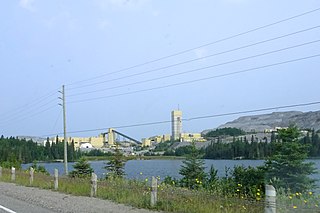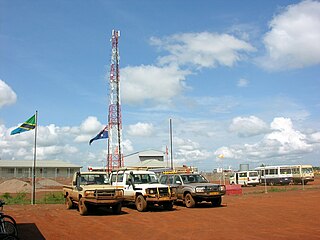
The economy of Tanzania is a lower-middle income economy that is overwhelmingly dependent on agriculture. Tanzania's economy has been transitioning from a command economy to a market economy since 1985. Although total GDP has increased since these reforms began, GDP per capita dropped sharply at first, and only exceeded the pre-transition figure in around 2007.

Barrick Gold Corporation is a mining company that produces gold and copper with 16 operating sites in 13 countries. It is headquartered in Toronto, Ontario, Canada. It has mining operations in Argentina, Canada, Chile, Côte d'Ivoire, Democratic Republic of the Congo, Dominican Republic, Mali, Papua New Guinea, Saudi Arabia, Tanzania, the United States and Zambia. In 2019, it produced 5.5 million ounces of gold at all-in sustaining costs of $894/ounce and 432 million pounds of copper at all-in sustaining costs of $2.52/pound. As of 31 December 2019, the company had 71 million ounces of proven and probable gold reserves.
Placer Dome Inc. was a large mining company specializing in gold and other precious metals, with corporate headquarters in Vancouver, British Columbia, Canada.

Kahama Urban District is one of the five districts of the Shinyanga Region of Tanzania. Its administrative centre is the town of Kahama. It is bordered to the north and south by Kahama Rural District, to the east by Nzega District and to the west by Bukombe District.

Tarime District is one of the seven districts of the Mara Region of Tanzania, East Africa. It was previously known as the "North Mara District". Its district capital is Tarime town. It is bordered from the north to east by the Kenyan districts of Migori, Trans Mara and Kuria East and West Districts, and to the east by the Maasai Mara game reserve. To the south it is bordered across the Mara River by the Serengeti and Butiama districts, and to the west by Rorya District.
John Lawson Thornton is an American businessman and professor and director of the Global Leadership Program at Tsinghua University in Beijing. He is also executive chairman of Barrick Gold Corporation and non-executive chairman of PineBridge Investments. Thornton stepped down as co-president of Goldman Sachs in 2003.
The mineral industry of Africa is the second-largest mineral industry in the world. Africa is the second largest continent, with 30.37 million square kilometre of land, which implies large quantities of resources. With a population of 1.216 billion living there. For many African countries, mineral exploration and production constitute significant parts of their economies and remain keys to economic growth. Africa is richly endowed with mineral reserves and ranks first in quantity of world reserves of bauxite, cobalt, industrial diamond, phosphate rock, platinum-group metals (PGM), vermiculite, and zirconium.

China National Gold Group Corporation (中国黄金集团有限公司) is a centrally state owned Chinese gold corporation primarily engaged in the mining and refining of gold, silver, copper, and molybdenum.
There are different methods by which gold mining companies are ranked. One is by their annual production. Another is by their cash cost per ounce, that is, how much money it costs them to mine the gold. Since gold prices are the same everywhere, companies with lower costs per ounce make more profit. The most common method lists by market capitalization which considers the total value of capital holdings by that company. Also considered when comparing companies is their market capitalization per ounce of gold equivalent which takes the market value and total reserves and resources for each company as well as the price of gold into consideration. The figures for each company can be used to determine the value the stock market gives to each company's reserves on an ounce to ounce basis.
The Sekenke Gold Mine was an underground gold mine in the Singida Region of Tanzania.
Tulawaka Gold Mine was a combined underground and open pit gold mine located in the Biharamulo district, in the Kagera Region of Tanzania. It is operated by African Barrick Gold, who owned 70% of the mine. The remaining 30% was owned by MDM Mines.
Bulyanhulu Gold Mine is an underground gold mine in the Shinyanga Region of Tanzania, located 55 kilometres south of Lake Victoria. It is one of three gold mines owned by Acacia Mining plc, formerly African Barrick Gold plc, a company owned by Barrick Gold, which is listed on the London Stock Exchange, and operates in Tanzania. Acacia also owns Buzwagi Gold Mine and the North Mara Gold Mine.

Buzwagi Gold Mine is an open pit gold mine in the Shinyanga Region of Tanzania, located 6 kilometres southeast from the town of Kahama. It is operated by Acacia Mining.
North Mara Gold Mine is a combined open pit and underground gold mine in the Tarime District of the Mara Region of Tanzania. It is one of three gold mines of Acacia Mining plc, a company listed on the London Stock Exchange, that operates in Tanzania, the other two being Bulyanhulu and the Buzwagi Gold Mine.
The Kirondatal Gold Mine was a gold mine in the Singida Region of Tanzania.

Kahama is a town in north-western Tanzania. The town serves as the headquarters of Kahama Urban District.

Tanzania is a land rich in minerals. Mining makes up more than 50% of the country's total exports, of which a large part comes from gold. The country has gold reserves of 10 million ounces, generating revenue of over a billion USD. Diamonds are also found in significant amounts. Since it was opened in 1940, the Williamson diamond mine has produced 19 million carats (3,800 kg) of diamonds. Gemstones, nickel, copper, uranium, kaolin, titanium, cobalt and platinum are also mined in Tanzania. Illegal mining and corruption are ongoing problems. In 2017, the government passed a series of bills aimed at increasing revenue from minerals after a scandal which caused the dismissal of the Minister for Energy and Minerals.








